Articles
- Page Path
- HOME > J Korean Acad Nurs > Volume 41(6); 2011 > Article
-
Original Article
- Comparison of Standardized Peristomal Skin Care and Crusting Technique in Prevention of Peristomal Skin Problems in Ostomy Patients
- Seungmi Park, Yun Jin Lee, Doo Nam Oh, Jiyun Kim
-
Journal of Korean Academy of Nursing 2011;41(6):814-820.
DOI: https://doi.org/10.4040/jkan.2011.41.6.814
Published online: December 31, 2011
1Assistant Professor, Department of Nursing & Research Institute for Basic Science, Hoseo University, Asan, Korea.
2Wound Ostomy Continence Nurse, Nursing Department, Severance Hospital, Seoul, Korea.
3Full time Lecturer, Department of Nursing & Research Institute for Basic Science, Hoseo University, Asan, Korea.
4Assistant Professor, Department of Nursing, Kyungwon University, Seongnam, Korea.
- Address reprint requests to: Kim, Jiyun. Department of Nursing, Kyungwon University, San 65 Bokjeong-dong, Sujeong-gu, Seongnam 461-701, Korea. Tel: +82-31-750-8822, Fax: +82-31-750-8859, jkim@kyungwon.ac.kr
© 2011 Korean Society of Nursing Science
- 1,234 Views
- 13 Download
- 5 Crossref
Abstract
-
Purpose
- This study was performed to compare the effects of standardized peristomal skin care (SPSC) and crusting technique (CT) on the peristomal skin of ostomates. SPSC was developed by a consensus among the expert group based on a comprehensive review of the relevant literature and hospital protocols.
-
Methods
- A randomized controlled pilot trial with 2 parallel arms was used. A total of 81 ostomates, who were recruited from a tertiary hospital, completed the baseline, 1-month, 2-month, and 3-month follow-up (SPSC group, n=45; CT group, n=36). SPSC consisted of water cleansing and direct application of ostomy appliances. CT involved crusting hydrocolloid powder and patting with water sponge or protective barrier liquid film. The outcomes of the study were assessed by skin problems, such as discoloration, erosion and tissue overgrowth; the domains of the evaluation tool used in examining the peristomal skin. A generalized estimating equation model was used to examine the effects according to time and group.
-
Results
- In both SPSC and CT groups, the likelihood of occurrence of discoloration (OR, 1.99; 95% CI, 1.61-2.46), erosion (OR, 1.87; 95% CI, 1.55-2.25) and tissue enlargement (OR, 1.94; 95% CI, 1.36-2.77) increased with time. There was no significant difference in discoloration between the groups, whereas the probability of erosion (OR, 0.38; 95% CI, 0.16-0.89) and tissue overgrowth (OR, 0.09; 95% CI, 0.02-0.55) was lower in the SPSC group than in CT group.
-
Conclusion
- SPSC was sufficient in preventing peristomal skin problems of ostomates compared to the CT.
INTRODUCTION
METHODS
RESULTS
DISCUSSION
CONCLUSION
This research was supported by Basic Science Research Program through the National Research Foundation of Korea (NRF) funded by the Ministry of Education, Science and Technology (2009-0067851).
- 1. Black PK. History and evolution of stomas. British Journal of Nursing. 1994;3(1):6–11.ArticlePubMed
- 2. Black P. Peristomal skin care: An overview of available products. British Journal of Nursing. 2007;16:1048–1054.ArticlePubMed
- 3. Clark J. Crusting method to heal denuded skin. 2005;Retrieved July 11, 2011. from http://www.groa.org/LCLPg%20161HTML.html.
- 4. Colwell JC, Goldberg MT, Carmel JE. fecal & urinary diversions: Management principles. 2004;St. Louis, Mosby.
- 5. Doughty D. Principles of ostomy management in the oncology patient. The Journal of Supportive Oncology. 2005;3:59–69.PubMed
- 6. Emory University Wound Ostomy & Continence Nursing Education Program. Ostomy and continent diversions module. 2006;Atlanta, Emory University Press.
- 7. Hampton BG, Bryant RA. Ostomies and continent diversions: Nursing management. 1992;St. Louis, Mosby.
- 8. Hoggarth A, Waring M, Alexander J, Greenwood A, Callaghan T. A controlled, three-part trial to investigate the barrier function and skin hydration properties of six skin protectants. Ostomy/Wound Management. 2005;51(12):30–42.
- 9. Issberner K, Schuren J. A comparative study of the skin protectant performance of five barrier films. 2004;Neuss, 3M Health Care Germany Laboratory.
- 10. Jemec GB, Martins L, Claessens I, Ayello EA, Hansen LH, Poulsen RG, et al. Assessing peristomal skin changes in ostomy patients: Validation of the ostomy skin tool. British Journal of Dermatology. 2011;164:330–335.ArticlePubMed
- 11. Jemec GB, Nybaek H. Peritstomal skin problems account for more than one in three visits to ostomy nurses. British Journal of Dermatology. 2008;159:1211–1212.PubMed
- 12. Kim JH, Lee SH, Ko YH, Oh SM, Yoon C, Ju HJ. A survey II for satisfaction for stoma on ostomates. Journal of the Korean Society of Coloproctology. 1999;15:31–35.
- 13. Martins L, Ayello EA, Claessens I, Steen Hansen A, Hentze Poulsen L, Sibbald RG, et al. The ostomy skin tool: Tracking peristomal skin changes. British Journal of Nursing. 2010;19:960–964.ArticlePubMed
- 14. Nix D, Ermer-Seltun J. A review of perineal skin care protocols and skin barrier product use. Ostomy/Wound Management. 2004;50(12):59–67.PubMed
- 15. Nybaek H, Jemec G. Skin problems in stoma patients. Journal of the European Academy of Dermatology and Venereology. 2010;24:249–257. doi: 10.1111/j.1468-3083.2010.03566.x.ArticlePubMed
- 16. Park KH, Chun HK, Park S. Wound ostomy. 2005;Seoul, Hyunmoonsa.
- 17. Park KH, Park JH, Lee EH, Kim EO, Jung YY, Sung YH. The effect of crusting technique on the peristomal skin care. Clinical Nursing Research. 2003;9:125–135.
- 18. Park S, Kim CS, Lee HO, Park JH, Lee YJ, Nam SY. Standardization of peristomal care for preventing peristomal skin problems. Supplement to Journal of Wound Ostomy Continence Nursing. 2010;37:3S. S99.
- 19. Park S, Kim KS. Affecting factors of end colostomy-related complications. Journal of Korean Academy of Adult Nursing. 2007;19:634–643.
- 20. Rochon J. Application of GEE procedures for sample size calculations in repeated measures experiments. Statistics in Medicine. 1998;17:1643–1658. doi: 10.1016/S0197-2456(97)91037-0.ArticlePubMed
- 21. Sung YH, Kwon I, Jo S, Park S. Factors affecting ostomy-related complications in Korea. Journal of Wound, Ostomy, and Continence Nursing. 2010;37:166–172. doi: 10.1097/WON.0b013e3181cf7b76.Article
REFERENCES
Figure & Data
REFERENCES
Citations

- Physicochemical Properties and Composition of Peristomal Skin Care Products: A Narrative Review
Agnieszka Kulawik-Pióro, Małgorzata Miastkowska, Katarzyna Bialik-Wąs, Piotr Zelga, Anna Piotrowska
Cosmetics.2025; 12(2): 74. CrossRef - The Validity, Reliability and Usability of the Studio Alterazioni Cutanee Stomali (SACS) and Ostomy Skin Tool (OST) Instruments for Classification of Peristomal Skin Disorders
Lien Degol, Ine Olaerts, Stijn Jacobs, Gregory Sergeant, Yves Depaifve, Kristel Paque, Koen Milisen
Journal of Wound, Ostomy & Continence Nursing.2025; 52(4): 303. CrossRef - Adapted Crusting Technique in Children with Peristomal Lesions: A Case Series
Ana Cristina Santos Monteiro, Maria Lucia Barbosa Maia dos Santos, Marcia Aparecida Souza, Juliana Caires de Oliveira Achili Ferreira
Advances in Skin & Wound Care.2020; 33(6): 329. CrossRef - Scientific and Clinical Abstracts From the WOCN® Society's 49th Annual Conference
Journal of Wound, Ostomy & Continence Nursing.2017; 44(Supplement): S1. CrossRef - Scientific and Clinical Abstracts From the WOCN® Society's 45th Annual Conference
Journal of Wound, Ostomy & Continence Nursing.2013; 40(Supplement): S1. CrossRef
Procedure of Standardized Peristomal Skin Care and Crusting Technique
Sample Characteristics at the Baseline (N=81)
*Fisher's exact test.
SPSC=Standardized peristomal skin care; CT=Crusting technique.
Discoloration, Erosion, Tissue Overgrowth, and DET Total Status at 1, 2, and 3 Months
*Reference was initial skin status at the time of randomization (0 month); †Fisher's exact test; *p<.05; **p<.01.
SPSC=Standardized peristomal skin care; CT=Crusting technique, DET total status: at least one abnormal skin problem such as discoloration, erosion, and tissue overgrowth.
Comparisons between Standardized Peristomal Skin Care and Traditional Crusting Technique for the Protection of Peristomal Skin
*CT group or baseline is the reference. Controlled variables are age, gender, ostomy type, and treatment. DET total status: at least one abnormal skin problem such as discoloration, erosion, and tissue overgrowth.
Characteristics of Ostomy Care
SPSC=Standardized peristomal skin care; CT=Crusting technique; *Only patients who answer this question were analyzed (n=74, SPSC group=45, CT group=29); †Only patients who answer this question were analyzed (n=63, SPSC group=37, CT group=26); KRW=Korean Won.
*Fisher's exact test. SPSC=Standardized peristomal skin care; CT=Crusting technique.
*Reference was initial skin status at the time of randomization (0 month); †Fisher's exact test; * SPSC=Standardized peristomal skin care; CT=Crusting technique, DET total status: at least one abnormal skin problem such as discoloration, erosion, and tissue overgrowth.
*CT group or baseline is the reference. Controlled variables are age, gender, ostomy type, and treatment. DET total status: at least one abnormal skin problem such as discoloration, erosion, and tissue overgrowth.
SPSC=Standardized peristomal skin care; CT=Crusting technique; *Only patients who answer this question were analyzed (n=74, SPSC group=45, CT group=29); †Only patients who answer this question were analyzed (n=63, SPSC group=37, CT group=26); KRW=Korean Won.
 KSNS
KSNS
 E-SUBMISSION
E-SUBMISSION
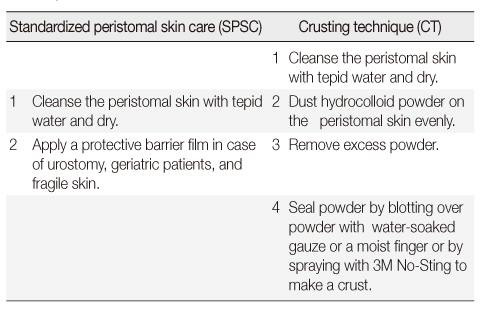
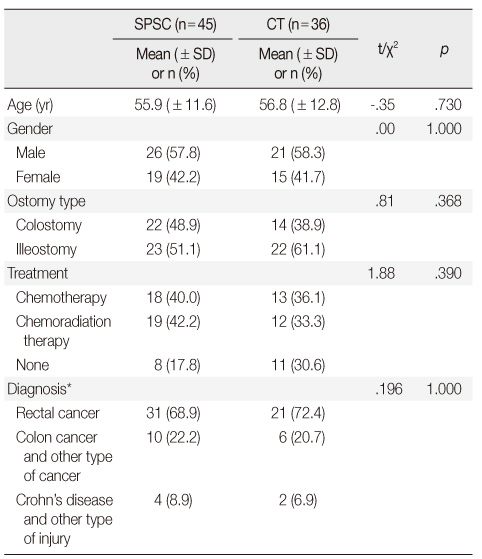
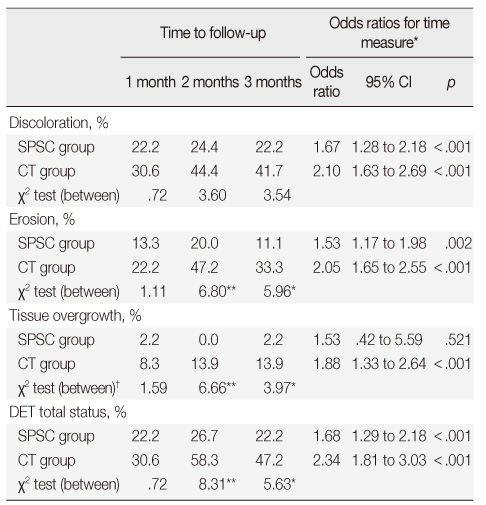
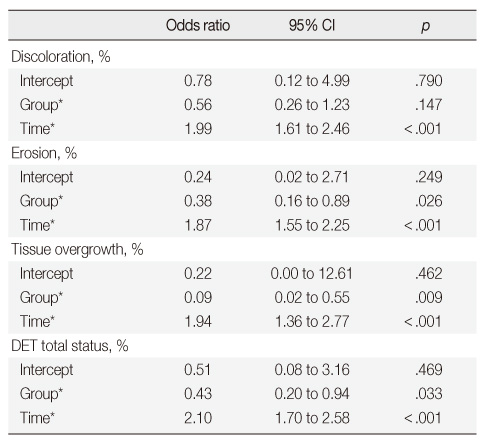
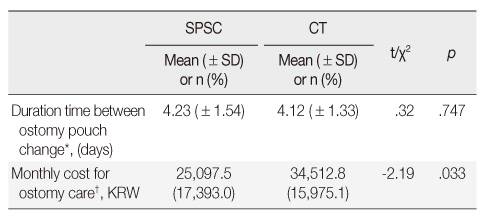
 Cite
Cite

